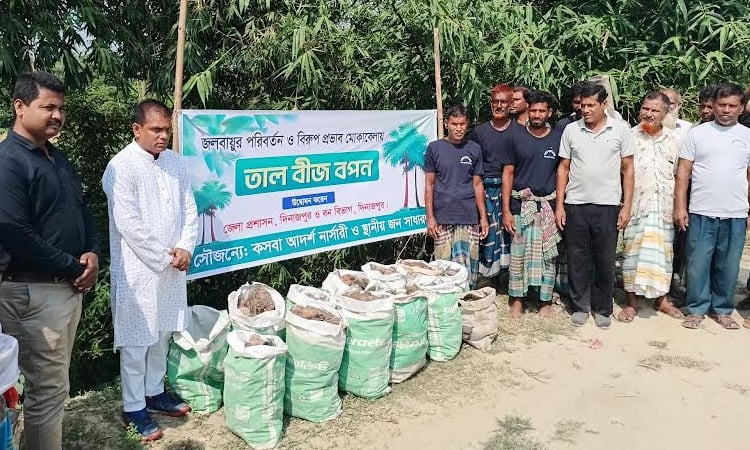News Flash
News Flash

DINAJPUR, Oct 25, 2025 (BSS) – Once a defining features of rural roadsides and village ghats, palm trees have been quietly disappearing from the Bangladeshi landscape.
In Dinajpur, however, a grassroots initiative is breathing new life into this vanishing species, not merely for its ecological charm and beauty, but as a vital life-saving shield against deadly lightning strikes.
In a collaborative initiative between the district administration and the forest department, over 1,000 palm seeds are being planted along the banks of the historic Ghagra Canal.
The goal is to restore ecological balance and reduce the rising number of deaths and injuries caused by lightning strikes.
Deputy Commissioner Md. Rafiqul Islam, who inaugurated the program on Friday afternoon in the Mission Road area, spoke passionately about the urgency of the effort.
“Palm trees once stood tall across our roads and settlements. But over the years, negligence and development projects have pushed them to the brink of extinction,” he said.
He explained that the absence of palm trees has contributed to a surge in lightning-related fatalities, particularly during the rainy season.
The planting drive spans both sides of the 9.5-kilometer Ghagra Canal, which connects Dinajpur city with Sadar upazila. The Deputy Commissioner assured that the full planting would be completed within two days, marking a symbolic and practical step toward environmental resilience.
Assistant Conservator of the Dinajpur Forest Department, Nurunnahar Begum said that the traditional Maharaja Girija Nath Ghagra Canal of Dinajpur is 9.5 kilometers long.
Of this, 3.5 kilometers are within Dinajpur city, while the remaining 6 kilometers are in Sadar upazila outside the city.
“We have started the work of planting 1,000 palm seeds on both sides of the Ghagra Canal. If additional palm seeds can be planted on both sides of the Ghagra Canal, we will also make arrangements,” she announced.
The forest department has also pledged to expand the initiative if additional seeds become available.
Officials said that agreements have been made with local residents, who will maintain the trees and enjoy their fruits once matured.
The effort has sparked civic pride, especially among the youth. Russell Ahmed (23) and Jewel Rana (24), residents of Mission Road, have volunteered to support the palm seeds plantation.
They announced that they would voluntarily do the work of planting palm seeds on the initiative of the district administration and the forest department along with other young people.
Mentioning that the incidence of lightning has increased greatly due to the extinction of palm trees, they said that it is their moral responsibility to preserve these palm trees for the sake of the country and themselves.
According to Bangladeesh Meteoroligical Department (BMD) and UN data reports, on an average artound 300 people die every year in the country due to lightening stricks. The highest number of fatalities reported in the northern districts like Sunamganj, Netrokona and Sylhet.
Farmers, fishermen, and outdoor laborers are the most affected groups of lightening stricks in Bangladesh, the data shared by the BMD added.